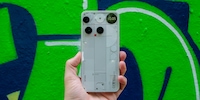

Razr 60 Ultra review: Motorola outdoes itself
Motorola has raised the bar for foldable smartphones so high with the new Razr 60 Ultra that even its strongest predecessor pales in comparison. There’s just one small snag that tarnishes the brilliant overall picture.
The predecessor of the Motorola Razr 60 Ultra, the Motorola Razr 50 Ultra, was already my favourite folding phone of 2024. Now Motorola is launching its successor with defining upgrades. In my opinion, it’s the perfect folding phone – despite coming with a small downgrade.
Design and exterior display: as always, full of possibilities
The version of the Motorola Razr 60 Ultra I tested features a wooden back, which I really like. In short, it’s compact, elegant and has a natural feel. The other models in green and pink also have special backs that are fabric-like. When closed, the device measures 8.8 × 7.4 × 1.6 cm and weighs just 199 g, so it fits perfectly in my trouser pocket.
The frame is made of matt polished aluminium, which really tops off the design. There are two buttons worth mentioning on this frame, the first being the power button, which also functions as a fingerprint sensor for quickly opening and locking the device. Motorola has also introduced a second button purely for the new AI features – more on that and its usefulness (or not) in the software section. This design decision shows that Motorola wants to make its AI as present and easily accessible as possible.
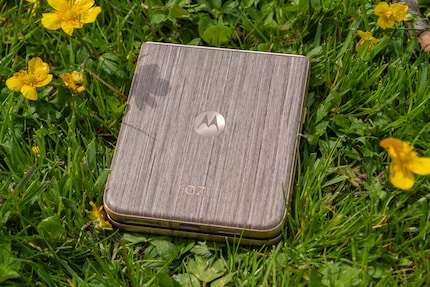
Motorola has equipped the foldable with the same 4-inch AMOLED external display as its predecessor. The refresh rate is 1 to 165 Hz, allowing me to scroll smoothly through all applications. And by that I really mean all of them: Motorola lets you install any apps, with the caveat that they might not always fit the display. Sometimes the two main cameras on the corner cover the buttons and information about an app. However, this rarely happens, as they’re usually displayed flush against but not over the cameras.

The manufacturer has adapted the display to feature the most important details, so the screen can easily accommodate your calendar, weather and notifications. Motorola also offers lots of games for the front display.
Hinge and inner display: robust with few compromises
When unfolded, the Motorola Razr 60 Ultra measures 17.2 × 7.4 × 0.7 cm. The surface doesn’t seem cheap, which is a far cry from the competition where the Samsung Galaxy Z Flip 6 feels really plasticky. I can slightly feel the crease, but it doesn’t bother me too much.
The slightly wider plastic frame around the display hiding the hinge is particularly eye-catching. While it makes the smartphone a bit wider, it still closes flush. And the hinge looks very robust. Nothing shakes, and it’s pleasant to open and close.
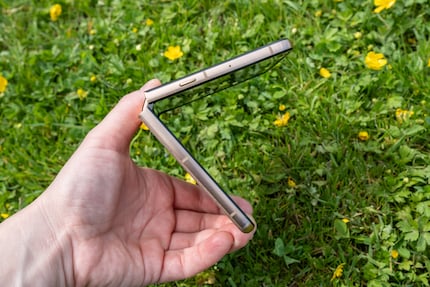
The Razr 60 Ultra is certified to protection class IP48, which allows it to be submerged in 1.5 m of fresh water for 30 minutes – same as the predecessor. What’s new is that dust particles 1 mm or larger no longer pose a problem.
In terms of display, the AMOLED measures 7 inches and shows the usual strong contrasts, dark black and bright colours. Peak brightness is 4,500 nits. Even though this extreme end of the scale is only possible for a short time, the display is bright enough. In other words, you can read everything easily in strong sunlight. As with the external display, the refresh rate is automatically adjusted between 1 and 165 Hz. This saves battery life and ensures a smooth experience.
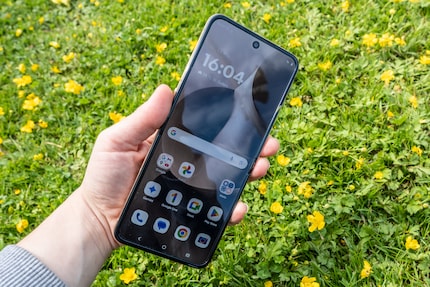
Hardware: Motorola is now in high-end territory
Motorola relies on the latest top hardware for the interior, with the biggest update being the chip. While the predecessor model, the Razr 50 Ulra, was still just below flagship level with its Snapdragon 8s Gen 3, Motorola has now opted for the most powerful chip on the market: the Snapdragon 8 Elite. By doing so, it keeps pace with other smartphones that also have this chip installed, such as the Oneplus 13 and the Samsung Galaxy S25. Due to the form factor – tight space – the device loses a few points in the Geekbench 6 benchmark. However, it’s the strongest of the foldables. The Samsung Galaxy Z Flip 6 with Snapdragon 8 Gen 3 lags a lot further behind.
In practice, the Motorola Razr 60 Ultra is incredibly agile. You can switch quickly between different apps and also play games without any issues. Even graphically intense titles such as Genshin Impact run at high graphics settings. However, the smartphone heats up quickly and then throttles the output. But when it comes to more basic games like Solitaire, there aren’t any problems. The myriad of games for the external display are also incredibly entertaining.
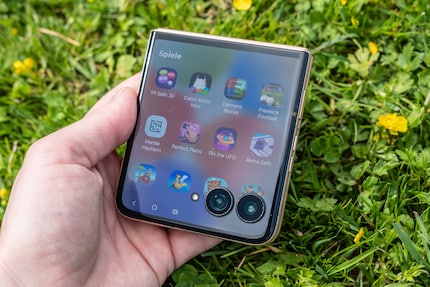
You get 512 GB of internal memory for all your apps, photos and videos. Motorola has also been generous with the RAM at 16 GB. But it’s worth mentioning that external memory cards aren’t compatible. Only one nanoSIM card fits into the slot. However, you can also use an eSIM. For optimum connectivity, the device comes with Wi-Fi 7 and Bluetooth 5.4 to keep you up to date, even though Bluetooth 6.0 is already waiting in the wings.
Motorola has increased the battery capacity from 4,000 to 4,700 mAh, which has obviously paid off. When I put it to the test with PCMark, which simulates everyday situations, the Razr 60 Ultra achieves a runtime of almost 17 hours. If I play games and make a lot of calls, the battery life drops significantly, but I can easily get it to last the day. The same test) reveals the competitor, Samsung’s Galaxy Z Flip 6, only has a battery life of just under 12 hours. At 13 hours, the predecessor was also well below this.
The Razr 60 Ultra also charges really quickly. With 68 W fast charging, it’s ready to use in under an hour. However, it does heat up quite a lot in the process. In contrast to its predecessor, the Razr 60 Ultra doesn’t come with a power adapter. You can wirelessly charge with up to 30 W and even return charge with 5 W (e.g. headphones).
Cameras: upgrades and downgrades
In terms of design, the cameras have the same disadvantage as their predecessor in that dirt collects on the lens rings. The cameras are also exposed, making them susceptible to scratches. That’s why I’d recommend using the cover they come with.
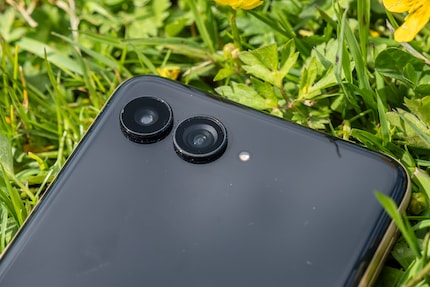
Motorola has decided to make a few changes since the last model. The sensor of the main camera is now slightly larger, measuring 1/1.56 inches instead of 1/1.95. This pays off in low light. Instead of a dual telephoto lens, there’s now an ultra-wide-angle. Digital magnification now helps when zooming, but this reduces the quality of the photo. Since the results are still acceptable, I can live with Motorola’s decision to banish the telephoto.
These are the cameras:
- main camera (wide-angle): 50 MP, f/1.8
- ultra-wide-angle: 50 MP, f/2.0
- selfie camera (wide-angle): 50 MP, f/2.0
Overall, I like the photos from the main camera. But they’re a bit too sharp and brash for me. However, this is in line with the current trend. Other manufacturers including Samsung and Apple are also focusing on bright, sharp snapshots. Motorola’s main lenses boast an impressive, chic bokeh for close objects.


The 2× digital zoom is fine for bringing subjects closer and only shows a slight loss of quality, for example with flat structures. This is more pronounced at 4× zoom, which I can really notice on the computer. Conversely, the photos look absolutely fine on my smartphone.



The selfie and ultra-wide-angle camera give a good impression. Both are very high-quality and hardly differ from the main camera.


Software: few updates, more AI
The Razr 60 Ultra comes with Android 15 and a whole host of pre-installed apps. This is due to the numerous Google functions and the myriad of apps from Motorola itself. In terms of third-party providers, the manufacturer has only hooked up with Perplexity. You need an account to use this AI app, which costs up to 18 francs per month. However, you can also use a free version, which acts as an alternative to Gemini and ChatGPT for everyday questions.
Conveniently, Motorola offers the «Smart Connect» app with the Razr 60 Ultra, which connects other devices to your smartphone via Wi-Fi or USB-C cable. For example, a Windows PC, an Android tablet or a smart TV. You can then export files, stream apps or even use your smartphone as a webcam. It all works well and quickly.
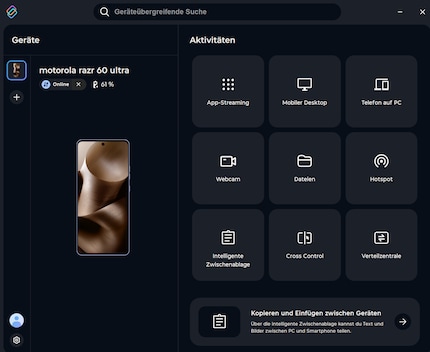
Motorola’s update policy, on the other hand, isn’t quite as gratifying. The manufacturer promises three years for Android and four years of security patches. That’s fine, but given the introductory price of over 1,000 francs or euros, I’d still like to see more. Competitors such as Samsung and Google already provide up to seven years of Android and security updates for their foldables.
Moto AI: powerful new features
Even though the word AI has me rolling my eyes, I can no longer avoid it. In terms of Motorola, the brand has integrated its own AI features in the form of Moto AI. I’m going to focus here on three useful ones.
To bring up the AI features, you press and hold the button on the side that Motorola has put here specifically for this purpose. Unfortunately, this can’t be reprogrammed, only deactivated. The features are mainly local. Anything that runs via the cloud requires your explicit authorisation.
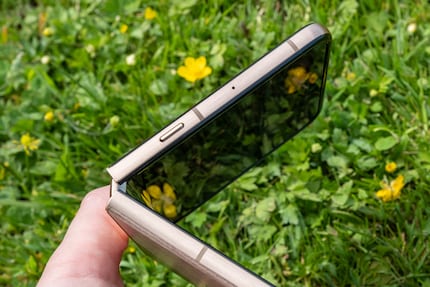
The options are currently only available in English, Portuguese and Spanish. Although inputs can also be in German, they’re then processed in the selected foreign language. This definitely needs to be expanded.
Notes: capture memories with text and images
You can create quick notes with this function. To do this, write a few lines or record a voice memo into the app. You can even add a snapshot if you want. The app then saves the entry and summarises the image, memo and text. Once again, this is available in English rather than German. Afterwards, you can use the search function to comb through the app for a desired entry.

Notifications: app round-ups
This is where you get a brief summary of the notifications from all your communication apps, or a selection of them of your choice – from phone calls to e-mails to WhatsApp. This is really useful if you receive an extremely large number of messages at once and want to see at a glance what’s most important.
Overview: create transcripts
Moto AI can also transcribe conversations and save them, including a summary, in the Notes app. My attempt to get it to transcribe a YouTube video with recipe instructions works well.
The transcription doesn’t contain a lot of errors and provides a good summary. All in all, it definitely helps when I’m overwhelmed with information and need to get an overview.
In a nutshell
Perfect if money is no object
The Motorola Razr 60 Ultra takes an impressive lead in the current folding smartphone market and even surpasses its already excellent predecessor. With its elegant design, versatile and huge external display, strong performance thanks to the Snapdragon 8 Elite chip and the long-lasting battery, this foldable offers a great overall package.
The smart AI functions dubbed «Moto AI» are interesting additions, even if their usefulness varies. Despite minor drawbacks, such as the lack of optical zoom and a fairly average update policy, Motorola delivers a well-engineered and innovative foldable smartphone that sets standards in its class. However, the recommended retail price is steep. Previous models have shown that it’s worth waiting for it to fall.
Pro
- Versatile external display
- High-quality design and feel
- Excellent performance thanks to Elite chip
- Powerful battery with fast charging
- Good cameras
Contra
- No optical zoom
- Fairly average update policy
- AI functions not yet fully available in German

In my world, Super Mario chases Stormtroopers with a unicorn and Harley Quinn mixes cocktails for Eddie and Peter at the beach bar. Wherever I can live out my creativity, my fingers tingle. Or maybe it's because nothing flows through my veins but chocolate, glitter and coffee.



